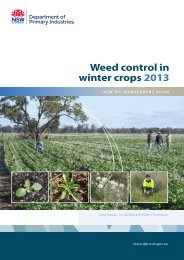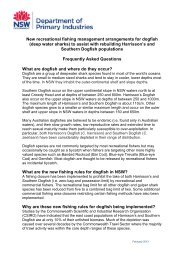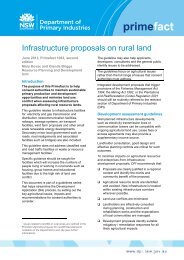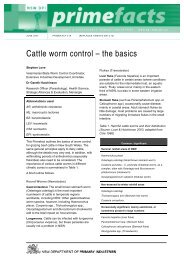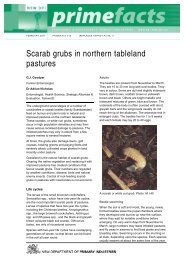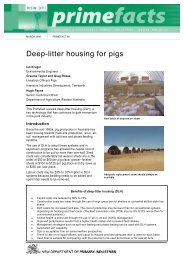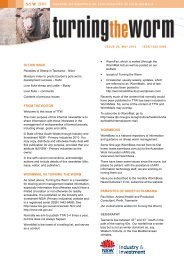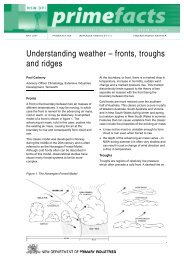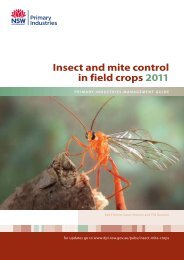Sustainable horticulture - NSW Department of Primary Industries ...
Sustainable horticulture - NSW Department of Primary Industries ...
Sustainable horticulture - NSW Department of Primary Industries ...
Create successful ePaper yourself
Turn your PDF publications into a flip-book with our unique Google optimized e-Paper software.
<strong>NSW</strong> DPI<br />
primefacts<br />
PROFITABLE & SUSTAINABLE PRIMARY INDUSTRIES www.dpi.nsw.gov.au<br />
MARCH 2006 PRIMEFAC T 144 , (REPLACES AGFACT H1.1.27)<br />
<strong>Sustainable</strong> <strong>horticulture</strong><br />
P D Newley<br />
District Horticulturist, Mid North Coast<br />
Intensive <strong>Industries</strong> Development<br />
N L Treverrow,<br />
Program Leader, Extensive Horticulture Systems,<br />
Intensive <strong>Industries</strong> Development<br />
Introduction<br />
<strong>Sustainable</strong> farming applies agricultural systems<br />
and practices which aim to maintain or enhance<br />
the health <strong>of</strong> the natural resource base within<br />
the constraints <strong>of</strong> the market based production<br />
system. In this framework this publication<br />
examines some <strong>of</strong> the benefits and challenges <strong>of</strong><br />
sustainable <strong>horticulture</strong> in <strong>NSW</strong>.<br />
The horticultural industries in <strong>NSW</strong> provide<br />
consumers with a variety <strong>of</strong> products, including<br />
fresh fruit and vegetables, wine, nuts, flowers<br />
and other ornamental and nursery products.<br />
Horticulture is a significant sector <strong>of</strong> the <strong>NSW</strong><br />
economy, with a farm gate value exceeding<br />
Our horticultural industries provide fruit and vegetables to local and export markets.<br />
$1 billion per annum, and it provides significant<br />
numbers <strong>of</strong> jobs in regional <strong>NSW</strong>.<br />
Horticultural activities inevitably have some<br />
impact on the natural resources harnessed for the<br />
production <strong>of</strong> fruit, vegetables and other products.<br />
As awareness <strong>of</strong> sustainability issues increases,<br />
horticultural industries are becoming increasingly<br />
concerned with maintaining and protecting their<br />
resource base and the wider environment.<br />
Some past and some current production systems<br />
have failed to address the impact they have on<br />
the environment resulting in the degradation<br />
<strong>of</strong> the natural resource base on both a local and<br />
landscape scale. Estimates suggest environmental<br />
degradation throughout the state costs $700m<br />
a year in lost production (Policy on <strong>Sustainable</strong><br />
Agriculture in New South Wales, 1998).<br />
The challenges facing current and future<br />
generations <strong>of</strong> horticultural producers are to<br />
increase sustainability by minimising their impact<br />
on the environment and to repair the effects <strong>of</strong><br />
past practices now known to be inappropriate to<br />
the Australian landscape. It is first necessary to<br />
have an economically viable production system if
2<br />
the costs <strong>of</strong> these investments in environmental<br />
enhancement are to be carried by the current<br />
generation <strong>of</strong> farmers.<br />
Impacts that need addressing include salinity,<br />
raised water tables, soil erosion and degradation,<br />
residues <strong>of</strong> persistent pesticides and <strong>of</strong>f-site<br />
impacts <strong>of</strong> nutrients. Positive action is needed<br />
now to protect, restore and enhance the natural<br />
resources our agriculture and <strong>horticulture</strong><br />
industries depend upon.<br />
As horticultural industries develop a better<br />
understanding <strong>of</strong> their production systems,<br />
growers are increasingly adopting best practice<br />
management approaches that aim to market<br />
a regular supply <strong>of</strong> safe, quality foodstuffs at<br />
reasonable cost to consumers whilst preserving<br />
the productivity <strong>of</strong> the landscape.<br />
To ensure the horticultural industries are<br />
sustainable, management strategies need to<br />
encapsulate practices that minimise impacts<br />
on the environment. Approaches such as<br />
Environmental Management Systems are being<br />
developed to facilitate the adoption <strong>of</strong> sustainable<br />
practices into the farm management system.<br />
Some <strong>of</strong> the key elements <strong>of</strong> farm management<br />
and the sustainability issues relating to them are<br />
discussed in the following pages.<br />
Planning for sustainability<br />
A key principle for sustainable agriculture is to<br />
take a holistic view <strong>of</strong> the industry at every level,<br />
from the individual plant/environment interaction<br />
through to the orchard and landscape level. The<br />
effects <strong>of</strong> an enterprise’s interactions with the<br />
wider environment are assessed on a generational<br />
timeframe to ensure the long-term health <strong>of</strong> the<br />
farming system. Short-term and problem focussed<br />
approaches that fail to recognise and account for<br />
the complexity <strong>of</strong> interrelations between activities<br />
on and <strong>of</strong>f the farm will not increase an enterprise’s<br />
sustainability. Planning needs to be considered at<br />
regional, local and individual enterprise levels.<br />
Regional planning<br />
About 75% <strong>of</strong> the <strong>NSW</strong> landscape is used for some<br />
form <strong>of</strong> agriculture. Horticultural production<br />
is mostly limited to land where soil depth,<br />
structure and fertility are suitable for cultivation<br />
<strong>of</strong> horticultural crops and a reliable source <strong>of</strong><br />
irrigation water is available.<br />
In recognition <strong>of</strong> the importance <strong>of</strong> natural<br />
resource management, the <strong>NSW</strong> government<br />
has recently established regional Catchment<br />
PRIMEFAC T 144 , SUSTAINABLE HORTICULTURE<br />
Productive river flats need protecting by local government<br />
planners.<br />
Management Authorities and the <strong>Department</strong><br />
<strong>of</strong> Natural Resources to direct community and<br />
government efforts in managing and enhancing<br />
the resource base. These reforms aim to keep<br />
our river systems in a healthy state whilst giving<br />
irrigators greater certainty in their access to<br />
water, and to conserve and enhance the natural<br />
vegetation <strong>of</strong> the state. New and existing<br />
horticultural enterprises will need to consult with<br />
the <strong>Department</strong> <strong>of</strong> Natural Resources for guidance<br />
on water harvesting and irrigation licences and<br />
with the Catchment Management Authorities<br />
before any clearing <strong>of</strong> native vegetation<br />
takes place.<br />
The <strong>NSW</strong> <strong>Department</strong> <strong>of</strong> Planning has recently<br />
embarked on projects to identify land that has<br />
regionally significant agricultural potential and to<br />
protect this land from development which reduces<br />
the productive potential <strong>of</strong> the region.<br />
Local planning<br />
Local councils have a responsibility to protect the<br />
future productivity <strong>of</strong> their local government areas<br />
for economic, social and aesthetic reasons. In some<br />
parts <strong>of</strong> the state productive horticultural land<br />
needs to be protected from competing demands<br />
from an increasing population (rural vs residential<br />
vs recreational land use).<br />
Where settlement encroaches on horticultural<br />
areas, there may be conflict with neighbours if<br />
farming operations generate excessive noise,<br />
odours or dust. Frost control equipment as<br />
pumps operated at night, bird and fruit bat<br />
scaring guns, hail netting, pesticides and use<br />
<strong>of</strong> pesticide application equipment, processing<br />
sheds and composting operations have all caused<br />
neighbourhood conflict.<br />
All these potential conflicts need to be considered<br />
when developing local planning instruments.<br />
Consultation and cooperation between industry,
local authorities and the community will ensure<br />
local planning instruments recognise and protect<br />
prime agricultural land and avoid conflicts that<br />
may render some <strong>of</strong> our limited horticultural land<br />
unproductive.<br />
Individual farm planning<br />
Recognition that each property is part <strong>of</strong> a greater<br />
landscape will assist farmers to develop property<br />
plans that will better enable their crops and<br />
cropping practices to coexist with the surrounding<br />
environment.<br />
By applying whole farm planning farmers are<br />
able to better define the limitations <strong>of</strong> their<br />
soils, landscape and climate and locate each<br />
farming system on the most suitable parts <strong>of</strong> their<br />
properties whilst retaining native vegetation on<br />
the parts best suited for conservation. In this<br />
process key areas <strong>of</strong> sustainable vegetation, water,<br />
soil and crop management can be considered in a<br />
total farm picture. The location <strong>of</strong> farm dams and<br />
drainage systems and areas suitable for irrigation<br />
are determined as part <strong>of</strong> this process.<br />
Once a whole-<strong>of</strong>-farm plan is worked out<br />
sustainable management <strong>of</strong> the enterprise can be<br />
developed. While there are many ways <strong>of</strong> viewing<br />
the whole farm picture, this can be done by<br />
considering four major areas, as below.<br />
<strong>Sustainable</strong> vegetation management<br />
Stonefruit protected by a windbreak. Windbreaks increase biodiversity and reduce water use.<br />
Vegetation management is a critical component <strong>of</strong><br />
sustainable horticultural management, particularly<br />
in its contribution to biodiversity, protection <strong>of</strong><br />
soils and management <strong>of</strong> water tables.<br />
Vegetation management should be considered on<br />
a whole farm scale when planning the layout <strong>of</strong><br />
the farm and on a paddock scale when planning<br />
which crops to grow. Opportunities to retain<br />
stands <strong>of</strong> native vegetation should be taken as<br />
they have a positive effect on farm and over the<br />
wider landscape. Benefits include the provision<br />
<strong>of</strong> habitat for birds and other pest control<br />
agents, wind protection for crops, and associated<br />
reduction in irrigation demand.<br />
Farmers also need to consider how the property<br />
fits into the surrounding landscape when<br />
designing the farm layout. A well thought out<br />
farm plan will incorporate wind breaks, retain or<br />
replant vegetation corridors, and have buffer zones<br />
between different cropping areas and adjacent<br />
to waterways, to limit the <strong>of</strong>f-site impact farming<br />
operations will have.<br />
Trees also have a positive hydrological effect on<br />
a landscape scale by drawing water up from the<br />
subsoil and/or water table which will help protect<br />
arable land from the disastrous effect <strong>of</strong> rising<br />
water tables and increased salinity.<br />
PRIMEFAC T 144 , SUSTAINABLE HORTICULTURE 3
4<br />
<strong>NSW</strong> DPI has Trees on Farms coordinators who can<br />
advise on establishment and management <strong>of</strong> trees<br />
for shade and shelter, nature conservation and soil<br />
and water conservation<br />
<strong>Sustainable</strong> water management<br />
A healthy river system is essential for a healthy<br />
environment and a productive agricultural sector.<br />
The health <strong>of</strong> most Australian rivers has been<br />
declining as demands for water have increased<br />
over recent decades. This has necessitated the<br />
introduction <strong>of</strong> a range <strong>of</strong> water reform regulations<br />
over recent years. It is recognised that rivers need<br />
to have sufficient flow for the ecological processes<br />
in the catchment and to provide water <strong>of</strong> suitable<br />
quality for domestic use and irrigators.<br />
Horticulture must compete for water with other<br />
needs such as town water supplies, industrial<br />
uses, environmental flows and recreational uses.<br />
Supplies are limited and efficient use <strong>of</strong> allocations<br />
is essential for the sustainability <strong>of</strong> <strong>NSW</strong><br />
horticultural industries into the future.<br />
As well as efficiency and cost issues there are<br />
important environmental issues at stake. Overirrigation<br />
and poor management <strong>of</strong> drainage<br />
water leads to major changes to the hydrological<br />
characteristics <strong>of</strong> the catchment and can have<br />
detrimental effects on other producers and the<br />
environment many miles downstream. The loss <strong>of</strong><br />
previously productive land to raised water tables<br />
and the associated salinisation <strong>of</strong> soils is occurring<br />
on a serious scale.<br />
A well planned and managed irrigation and<br />
drainage system should achieve a healthy vigorous<br />
crop with very little run-<strong>of</strong>f above the natural level,<br />
only small losses to the water table and minimum<br />
discharge <strong>of</strong> salt, fertiliser, pesticides and organic<br />
matter into the river system. All aspects <strong>of</strong> water<br />
management have to be considered at the<br />
design stage, including system design, irrigation<br />
scheduling, water quality, fertigation options, and<br />
drainage management.<br />
Horticultural producers can improve their use <strong>of</strong><br />
water by developing a better understanding <strong>of</strong><br />
the interaction between the crops and the soils<br />
in which they grow and an increased knowledge<br />
<strong>of</strong> the fate <strong>of</strong> water applied. Once crop demands<br />
and soil water holding capacity are determined,<br />
irrigation can be scheduled and applied more<br />
precisely with a much reduced effect on the<br />
environment.<br />
Irrigation scheduling at its simplest uses<br />
evaporation figures from meteorological stations,<br />
and crop factors, to predict how much water<br />
PRIMEFAC T 144 , SUSTAINABLE HORTICULTURE<br />
demand is likely in a crop, and how much irrigation<br />
needs to be applied. Far more accurate scheduling<br />
can be obtained by using various soil moisture<br />
monitoring systems. These accurately measure<br />
moisture levels in the root zone, and allow very<br />
accurate application <strong>of</strong> water to meet crop<br />
demands while avoiding either excesses or deficits.<br />
Real time monitoring and computerised systems<br />
can supply a crop’s irrigation needs with a high<br />
degree <strong>of</strong> precision.<br />
Another major factor in efficient water use is<br />
the delivery system. A wide range <strong>of</strong> irrigation<br />
technologies are used in horticultural crops. These<br />
include furrow irrigation, overhead irrigation,<br />
drip and trickle systems and low-pressure undertree<br />
systems. Irrigation efficiency increases with<br />
increasing precision <strong>of</strong> water delivery. Flood<br />
irrigation is generally least efficient. High pressure,<br />
high volume sprinkler systems covering wide areas<br />
are considerably less efficient than micro sprinklers<br />
or dripper systems which target the root zone <strong>of</strong><br />
the crop.<br />
The delivery system is an important investment<br />
and cost should not be the deciding issue in<br />
selection. Generally the higher technology systems<br />
are more expensive but give growers the ability to<br />
apply water with a high degree <strong>of</strong> precision, which<br />
not only benefits the crop, but also allows for<br />
very efficient use <strong>of</strong> water and avoids losses and<br />
associated <strong>of</strong>f-site impacts.<br />
Another major benefit is the use <strong>of</strong> the irrigation<br />
system for fertigation. In these systems dissolved<br />
fertiliser is supplied to the crop through an<br />
irrigation system. This facilitates frequent small<br />
applications <strong>of</strong> fertiliser that supply nutrients<br />
to the root zone as needed and reduce the risk<br />
<strong>of</strong> nutrients being transported <strong>of</strong>f-site by run<strong>of</strong>f.<br />
Labour input and compaction by machinery<br />
delivering fertiliser to the plants is also reduced.<br />
In this way both water and fertiliser use can be<br />
managed to obtain optimal yields <strong>of</strong> high quality<br />
A trickle irrigation system delivers water to a young<br />
vineyard.
A tensiometer measures soil moisture for precise irrigation<br />
management.<br />
product, while minimising the impact on the wider<br />
environment.<br />
The <strong>NSW</strong> Government is investing in education<br />
strategies to help irrigators develop ‘land and<br />
water management plans’ which aim to increase<br />
efficiency and minimise <strong>of</strong>f-farm impacts <strong>of</strong><br />
irrigated <strong>horticulture</strong>. The increasing cost <strong>of</strong><br />
irrigation water is also driving a move to more<br />
efficient irrigation systems.<br />
<strong>Sustainable</strong> soil management<br />
A primary goal <strong>of</strong> sustainable <strong>horticulture</strong> is to<br />
protect and enhance soil health. No farming<br />
system can be sustained unless the soil has<br />
suitable fertility, structure, water holding capacity,<br />
drainage capacity and sufficient depth. Topsoil<br />
forms very slowly and is, in terms <strong>of</strong> the human life<br />
cycle, irreplaceable.<br />
It is important to increase awareness <strong>of</strong> the<br />
causes, symptoms and consequences <strong>of</strong> soil<br />
degradation. Growers should protect their land<br />
from soil loss due to erosion by wind or water and<br />
to more closely monitor the chemical and physical<br />
condition <strong>of</strong> the soil so that tillage and fertiliser<br />
practices can be better managed.<br />
Erosion controls<br />
Erosion control begins at the farm planning level.<br />
Some areas are simply too erosion prone to sustain<br />
horticultural activity. An obvious example is very<br />
steep slopes. These should be either left uncleared<br />
(land clearing regulations specifically prohibit<br />
general clearing <strong>of</strong> steep slopes) or if they are<br />
already cleared, cover crops and trees should be<br />
planted to stabilise them.<br />
Incorporation <strong>of</strong> windbreaks into farm plans will<br />
slow wind velocity, and reduce soil loss due to<br />
wind erosion. When planting windbreaks the<br />
mature size and shape <strong>of</strong> the windbreak needs<br />
to be considered. A combination <strong>of</strong> tall and low<br />
growing species may be needed. Information on<br />
suitable species for different areas and needs is<br />
available from a number <strong>of</strong> sources, and checking<br />
local experience is a good indicator.<br />
Well-designed and managed farm irrigation and<br />
drainage systems will reduce soil loss due to run<strong>of</strong>f<br />
by minimising the quantity and speed <strong>of</strong> water<br />
flowing through the crop. Well-designed drainage<br />
systems are particularly important, as they can<br />
slow the movement <strong>of</strong> water during rainfall and<br />
direct run-<strong>of</strong>f into suitable areas. Maintaining<br />
cover crops on these drainage systems is essential<br />
to preventing erosion.<br />
Most perennial <strong>horticulture</strong> industries grow interrow<br />
cover crops between the trees which, among<br />
other benefits, protect soils from erosion by wind<br />
or water. Incorporating strip cropping and green<br />
manure crops in vegetable production systems<br />
also protects soil from wind and water erosion.<br />
While contributing to soil protection cover crops<br />
also assist in weed management and enhance the<br />
biodiversity <strong>of</strong> the soil, which benefits soil health.<br />
Mulching under tree crops can also be used to<br />
protect soil against erosion by water or wind, as<br />
well as adding valuable organic matter to the soil.<br />
The use <strong>of</strong> permanent beds or tram tracks in<br />
crops with frequent vehicle movements, such<br />
as vegetables, restricts compaction to a small<br />
percentage <strong>of</strong> the field, increases the infiltration<br />
rate <strong>of</strong> the soil, and therefore reduces run-<strong>of</strong>f and<br />
associated soil loss. Restricting vehicle movements<br />
when the soil is wet also reduces the likelihood <strong>of</strong><br />
soil compaction.<br />
Organic matter<br />
Organic matter and the humus it breaks down<br />
to are vital to sustaining the productive life <strong>of</strong><br />
the soil. Humus helps bind soil particles into<br />
aggregates and improves soil structure. In turn this<br />
improves aeration and drainage, as well-structured<br />
soils allow water and air to pass through the<br />
soil more easily. Organic matter and humus also<br />
improve the moisture holding capacity <strong>of</strong> the soil.<br />
Organic matter can also provide a slow release<br />
form <strong>of</strong> nutrients, and even more importantly,<br />
humus can attract and hold large amounts <strong>of</strong><br />
nutrients in the soil so that applied fertilisers are<br />
better protected against leaching.<br />
PRIMEFAC T 144 , SUSTAINABLE HORTICULTURE 5
6<br />
Tomatoes fertilised through the trickle irrigation system.<br />
Organic matter levels can be maintained or<br />
increased through a number <strong>of</strong> practices. Cover<br />
crops make a valuable contribution, particularly<br />
through the contribution <strong>of</strong> dead roots. Generally<br />
crops with dense fibrous roots are more useful<br />
than those which have fewer fleshier deep roots.<br />
Inter-row cover crops in orchards can also be<br />
mown and put into the crop row to supply leaf<br />
matter to the crop row litter.<br />
Incorporation <strong>of</strong> green manure crops can provide<br />
short-term increases in organic matter as well as<br />
protection for the soil during a fallow.<br />
Bulky organic manures can increase organic matter<br />
but frequent and heavy applications are needed.<br />
Where this activity is a fundamental part <strong>of</strong> the<br />
enterprise (such as with organic production) it<br />
can be worthwhile but applications are generally<br />
energy intensive. Cover crops may be a simpler<br />
way to produce bulk organic matter.<br />
Crop residues can be another good source<br />
<strong>of</strong> organic matter, provided their retention is<br />
compatible with the good crop hygiene essential<br />
for disease management. Pest and disease guides<br />
will indicate where crop hygiene is an issue.<br />
As well as adding organic matter to the system,<br />
minimising cultivation, which breaks down organic<br />
matter and exposes humus, will prolong the life <strong>of</strong><br />
existing organic matter.<br />
Nutrient management<br />
The challenge in managing crop nutrition is to<br />
supply the nutrient levels required at the right<br />
time to meet crop demands whilst preventing<br />
on-site soil degradation and minimising <strong>of</strong>f-site<br />
movement <strong>of</strong> nutrients.<br />
PRIMEFAC T 144 , SUSTAINABLE HORTICULTURE<br />
The most basic approach is to use indicative<br />
fertiliser programs that can be obtained for<br />
most crops. Some have been derived from<br />
experimentation on crop responses whilst others<br />
are derived by calculating the amount <strong>of</strong> nutrients<br />
expected to be exported from the field in the form<br />
<strong>of</strong> product, pruning and leaching.<br />
These indicative fertiliser recommendations are<br />
only a guideline to the likely use for the season<br />
and fail to account for differences in soil/crop<br />
interactions. They lack precision and may result<br />
in crop reduction and/or <strong>of</strong>f-site nutrient losses.<br />
More timely feedback is needed to develop a more<br />
precise nutrition strategy.<br />
A widely used source <strong>of</strong> such feedback is the<br />
regular use <strong>of</strong> soil and leaf tests which allow<br />
growers to balance nutrient use and fine tune<br />
their fertilising choices. Typically, soil and tissue<br />
tests are made once or twice a year. In some crops<br />
growers gain further information by using sap<br />
testing which provides a very immediate picture <strong>of</strong><br />
the plant’s nutrient status.<br />
Once the nutrient status <strong>of</strong> the soil and plant<br />
are known, this information is combined with<br />
knowledge <strong>of</strong> the crop cycle to apply the amounts<br />
<strong>of</strong> fertiliser needed. Applications need to be made<br />
in small amounts at the right times in the crop<br />
cycle. Crop calendars provide this information for<br />
most horticultural crops.<br />
A thorough understanding <strong>of</strong> the fate <strong>of</strong> the range<br />
<strong>of</strong> fertiliser products will enable producers to<br />
choose products that will best achieve their aims<br />
without any detrimental after effects. For example<br />
some forms <strong>of</strong> nitrogen fertiliser are much less<br />
acidifying than others and should be the preferred
choices. Growers need also be aware that some<br />
fertilisers contain certain heavy metals that can<br />
accumulate in some soils to levels where crops<br />
may become unsafe for consumption and the land<br />
becomes less useful.<br />
For the producer, the most immediate benefit <strong>of</strong> a<br />
good nutrient management strategy is optimum<br />
productivity and quality at a minimum cost. At<br />
the same time these activities can ensure good<br />
outcomes for sustainable production, by avoiding<br />
soil degradation through acidification or salting,<br />
and ensuring the areas outside the crop, the farm,<br />
and ultimately the catchment area, are protected<br />
from the adverse effects <strong>of</strong> nutrient run-<strong>of</strong>f.<br />
<strong>Sustainable</strong> pest management<br />
Having achieved sustainable production by<br />
maintaining water and soil health, the challenge<br />
then is to protect this production from the threat<br />
<strong>of</strong> various pests. To do this sustainably requires<br />
a balanced approach that maximises the use <strong>of</strong><br />
natural control agents and minimises pesticide<br />
use when controlling insects, diseases and<br />
weeds. Integrated pest management programs<br />
are available to achieve this aim, and are under<br />
constant development for a wide range <strong>of</strong><br />
cropping situations.<br />
Integrated pest management (IPM) uses a<br />
combination <strong>of</strong> biological, physical, cultural,<br />
genetic and chemical control methods to manage<br />
weeds, insects and diseases. IPM requires growers<br />
to have a thorough understanding <strong>of</strong> crop growth<br />
stages, the lifecycle <strong>of</strong> pests and the conditions<br />
most favourable to the development <strong>of</strong> pest<br />
populations.<br />
Monitoring <strong>of</strong> crops and pests, either by direct<br />
observation, trapping with pheromones or other<br />
baits, or monitoring <strong>of</strong> seasonal conditions allows<br />
growers to predict the arrival <strong>of</strong> a harmful pest<br />
population or event and take action to prevent<br />
economic effects on crops.<br />
Although sounding complex, this approach is<br />
achievable and has changed the course <strong>of</strong> pest<br />
control in <strong>horticulture</strong>. Routine spraying programs<br />
using any available pesticides have given way to<br />
minimal treatments with s<strong>of</strong>ter chemicals that are<br />
less disruptive to biological control by beneficial<br />
organisms.<br />
IPM strategies provide the community with<br />
safer food and greater biodiversity. The grower<br />
may obtain additional benefit from lower costs,<br />
improved market access and a more sustainable<br />
system with less threat <strong>of</strong> losses caused by<br />
development <strong>of</strong> resistance to pesticides.<br />
Many IPM programs are available. Pest<br />
management guides and similar publications are<br />
designed to help growers use these systems.<br />
Weed management<br />
Weeds impact on productivity and on biodiversity.<br />
Good weed management benefits both<br />
agricultural production and the conservation and<br />
enhancement <strong>of</strong> natural resources.<br />
Integrated weed management combines<br />
management strategies such as fertiliser use,<br />
groundcover retention, cultivation, biological<br />
control and herbicide use. Such an approach can<br />
dramatically reduce the reliance on herbicide<br />
use, limit weed establishment and simultaneously<br />
encourage desirable plant species.<br />
In perennial <strong>horticulture</strong>, weed management, once<br />
a matter <strong>of</strong> routine spraying or ploughing, is now<br />
part <strong>of</strong> total orchard floor management. In general<br />
growers can use a combination <strong>of</strong> non-tillage<br />
methods such as mowing, selective herbicide<br />
application, cover crops and mulching for a healthy<br />
and protected orchard floor.<br />
Most perennial crops now have beneficial interrow<br />
cover crops that compete with weeds and are<br />
managed by mechanical means to out compete<br />
weeds and further reduce the need for herbicide<br />
use. Ground with a cover crop is less prone to<br />
weed establishment. Herbicides are still necessary<br />
along the rows but the range <strong>of</strong> herbicides now<br />
available provides plenty <strong>of</strong> options and have<br />
minimal adverse effect on the environment.<br />
Perennial weeds are <strong>of</strong>ten serious competitors<br />
for water and nutrients. Spot treatment <strong>of</strong> these<br />
weeds while they are young can be very cost<br />
effective and a far better option for sustainable<br />
management than later heavy herbicide treatment<br />
regimes over the entire planting.<br />
Timeliness is the key to minimising herbicide<br />
use. For example timely mowing <strong>of</strong> weeds in the<br />
inter-row areas reduces the competition for water<br />
and nutrients. Where mowing alone is insufficient,<br />
especially close to the crop, there are choices<br />
<strong>of</strong> contact, pre-emergence and translocated<br />
herbicides to give added management options.<br />
Timely preparation <strong>of</strong> orchards for harvesting,<br />
especially in nut orchards, is another important<br />
strategy. In other words the intensity <strong>of</strong><br />
management <strong>of</strong> weeds and cover crops can be<br />
varied through the year to suit the needs <strong>of</strong> overall<br />
orchard management.<br />
PRIMEFAC T 144 , SUSTAINABLE HORTICULTURE 7
8<br />
Apple orchard with inter-row covercrop.<br />
Cover crops<br />
The benefits <strong>of</strong> cover crops for erosion control<br />
and as part <strong>of</strong> the weed management plan<br />
in sustainable agriculture have already been<br />
discussed. Cover crops can also improve the<br />
habitat for beneficial insects by providing shelter<br />
and nectar for food. Leguminous cover crops can<br />
increase fixation <strong>of</strong> atmospheric nitrogen.<br />
Cover crops should be selected with overall crop<br />
management in mind. For example tall growing<br />
vigorous cover crops may be well suited to interrow<br />
plantings in annual vegetable crops while low<br />
growing, shade tolerant species are <strong>of</strong>ten most<br />
suitable for orchards <strong>of</strong> trees.<br />
Insect management<br />
Integrated pest management has replaced older<br />
approaches to pest control based on routine<br />
calendar spraying or spraying pests on sight.<br />
Biological control agents are important<br />
components <strong>of</strong> modern pest management systems.<br />
These are predators, parasites or disease agents<br />
which help control key pest insects. If too much<br />
spraying <strong>of</strong> the pest kills these biological control<br />
agents, then the key pest may rebound in even<br />
higher numbers, leading to a treadmill <strong>of</strong> spraying.<br />
PRIMEFAC T 144 , SUSTAINABLE HORTICULTURE<br />
Biological agents also <strong>of</strong>ten control a range <strong>of</strong><br />
other minor pests to the extent they are not a<br />
problem. If inappropriate spraying kills them, the<br />
minor pests may become major problems. Mites<br />
and scales are good examples <strong>of</strong> this induced pest<br />
syndrome.<br />
Some biological control agents are available<br />
commercially so they can be introduced to crops<br />
at strategic times. Their use is <strong>of</strong>ten much more<br />
effective if applied in response to specific stages<br />
in the pest life cycle and changes in the season.<br />
Wasp parasites for control <strong>of</strong> some scale insects<br />
and mealy bugs and predatory mite for control<br />
<strong>of</strong> spider mites are examples <strong>of</strong> commercially<br />
available biological control agents.<br />
Protecting and encouraging the fauna <strong>of</strong> beneficial<br />
organisms is a major aim <strong>of</strong> IPM. For that reason<br />
the choice <strong>of</strong> ‘s<strong>of</strong>t’ insecticides, which have<br />
minimal effect on beneficial insects, and minimal<br />
use <strong>of</strong> sprays generally, is an important part <strong>of</strong><br />
sustainable pest management.<br />
To achieve minimal spraying <strong>of</strong> insect pests it is<br />
essential to monitor insect populations to know<br />
when a serious problem is developing. Economic<br />
thresholds for pests indicate what numbers are<br />
likely to be more costly in damage than the<br />
treatment costs.
By monitoring pest numbers and considering<br />
thresholds it is possible to greatly reduce<br />
insecticide usage compared to the ‘calendar’<br />
approach. Pest scouts operating in many industries<br />
can monitor insect populations in a range <strong>of</strong> crops<br />
and give specific advice to growers about the best<br />
pest control strategies to follow.<br />
A further problem addressed by minimal spraying<br />
is the capacity <strong>of</strong> many pests to develop resistance<br />
to pesticides. This process is accelerated by<br />
frequent treatments, especially if only one type <strong>of</strong><br />
insecticide is used. Using a range <strong>of</strong> insecticides<br />
<strong>of</strong> different classes will assist. Further advice on<br />
resistance management strategies is available in<br />
many pest and disease guides.<br />
A special class <strong>of</strong> biocontrol organisms known as<br />
biocides, includes insect killing bacteria, fungi and<br />
nematodes, that can be used as a spray in place<br />
<strong>of</strong> conventional insecticides for some pests. They<br />
generally have limited application but can be very<br />
effective in the right situations. Because they are<br />
<strong>of</strong>ten host specific and very low in mammalian<br />
toxicity they make an excellent choice where<br />
appropriate.<br />
Where available, crops with resistance or tolerance<br />
to important insect pests also reduce dependence<br />
on conventional insecticides.<br />
The use <strong>of</strong> insecticides in <strong>horticulture</strong> has reduced<br />
considerably over the last several years as a result<br />
<strong>of</strong> industry funded research, much <strong>of</strong> which is<br />
improving IPM strategies.<br />
Disease control<br />
A good starting point for sustainable disease<br />
control is the use <strong>of</strong> plant varieties that are<br />
resistant or tolerant to troublesome diseases such<br />
as Fusarium in tomatoes, canker in stonefruit, and<br />
Panama disease in bananas.<br />
Many horticultural tree crops utilise rootstocks<br />
that are resistant to key soil borne diseases or<br />
pests. In cases such as citrus and avocados the<br />
budwood can potentially be infected with diseases<br />
and accreditation schemes are available to ensure<br />
the grafting material is free <strong>of</strong> disease. Ensuring<br />
planting material is from accredited nurseries<br />
utilising good quality resistant rootstocks is<br />
an important fundamental step to sustainable<br />
production. Vegetable breeders are constantly<br />
developing new varieties with disease resistance.<br />
Minimising pesticide applications for disease<br />
control is another element <strong>of</strong> sustainable disease<br />
management. Timely and targeted applications <strong>of</strong><br />
the appropriate treatment can save on pesticide<br />
applications in the longer term by giving more<br />
efficient control.<br />
Weather data is used for disease forecasting.<br />
One <strong>of</strong> the best ways to ensure timely treatment<br />
is by using predictive systems. Disease control<br />
strategies have been developed in a range <strong>of</strong><br />
crops that use weather data to predict high-risk<br />
conditions and allow growers to apply fungicides<br />
when and where they are most effective.<br />
Another essential aspect <strong>of</strong> sustainable disease<br />
management is to avoid resistance to the<br />
pesticides used. Modern disease programs clearly<br />
spell out rotation strategies using different groups<br />
<strong>of</strong> pesticides to reduce the risk <strong>of</strong> resistance<br />
developing.<br />
Finally cultural control by good crop hygiene<br />
(the removal <strong>of</strong> crop residues which can be a<br />
disease reservoir) is another essential element <strong>of</strong><br />
sustainable disease management.<br />
Increased skill levels in using pesticides<br />
Over 100 000 farmers in Australia have completed<br />
a farm chemical user course. Farmers find<br />
this course very beneficial in increasing their<br />
understanding <strong>of</strong> pest management strategies and<br />
become more confident when deciding on which<br />
pest management method to apply to specific<br />
situations.<br />
The course also teaches farmers how to choose<br />
the most effective equipment for the task and<br />
keep it operating correctly so that any pesticides<br />
applied remain on target and <strong>of</strong>f-site impacts are<br />
minimised.<br />
Conclusion<br />
<strong>Sustainable</strong> <strong>horticulture</strong> builds on the longstanding<br />
desire <strong>of</strong> farmers to ensure their land<br />
remains productive into the future. It also<br />
addresses the community’s expectations and<br />
concerns for safe food and for environmental<br />
protection.<br />
PRIMEFAC T 144 , SUSTAINABLE HORTICULTURE 9
10<br />
<strong>Sustainable</strong> horticultural systems can be achieved<br />
by appropriate planning and by building on the<br />
general Best Practice Management approach<br />
increasingly employed by modern horticultural<br />
enterprises to achieve a holistic approach to their<br />
farming system.<br />
The issues for a sustainable horticultural system,<br />
outlined in the preceding pages are to:<br />
• Protect and enhance existing native vegetation<br />
for greater biodiversity and security <strong>of</strong> the rural<br />
environment at large;<br />
• Manage the use <strong>of</strong> scarce water resources<br />
to ensure greatest efficiency, productivity<br />
and protection <strong>of</strong> surrounding catchments<br />
and waterways from salt, soil, fertilisers and<br />
chemicals carried in run-<strong>of</strong>f water;<br />
• Manage for healthy soils through protection from<br />
degradation and loss by erosion, organic matter<br />
depletion and unbalanced and inappropriate<br />
fertiliser usage;<br />
• Manage the impact <strong>of</strong> pest and diseases<br />
while minimising the usage <strong>of</strong> chemicals and<br />
maximising pr<strong>of</strong>itability over the short and<br />
long term.<br />
Increasingly, systematic management plans such<br />
as Environmental Management Systems are being<br />
developed to assist horticultural enterprises to<br />
be sustainable, integrated into the overall rural<br />
A well managed blueberry farm.<br />
PRIMEFAC T 144 , SUSTAINABLE HORTICULTURE<br />
environment, and pr<strong>of</strong>itable by producing the<br />
range <strong>of</strong> premium products required by the<br />
market place.<br />
References<br />
<strong>NSW</strong> Agriculture, (1998). Policy for sustainable<br />
agriculture in <strong>NSW</strong><br />
Suggested other publications and references<br />
Burlace, Michael (2000). Organic farming: an<br />
introduction. C. B. Alexander Agricultural College<br />
Continuing Education, <strong>NSW</strong> Agriculture Home<br />
Study Program<br />
Firth, D. J. (2000). Mulching tree and vine crops on<br />
the north coast. <strong>NSW</strong> Agriculture<br />
George, D., Brouwer, D.W., (1996). Nature<br />
conservation on farms. <strong>NSW</strong> Agriculture<br />
Laffan, L. J. (2000) Organic farming: soils, crops,<br />
fruits and vegetables. C. B. Alexander Agricultural<br />
College Continuing Education, <strong>NSW</strong> Agriculture<br />
Home Study Program<br />
McMullen, Bernie (1996). Improved soil<br />
management for sustainable perennial <strong>horticulture</strong><br />
in <strong>NSW</strong>. Final report. <strong>NSW</strong> Agriculture
Newley, P. D. (1995). Irrigation scheduling for fruit<br />
growers. <strong>NSW</strong> Agriculture, Murray and Riverina<br />
Region<br />
<strong>NSW</strong> DPI, Grapevine management guide (latest<br />
edition)<br />
Penrose L. J., Thwaite W. G., Slack J. M. (2000).<br />
Orchard plant protection guide, <strong>NSW</strong> Agriculture (or<br />
latest edition)<br />
Salvestrin, J. (1991) Australian vegetable growing<br />
handbook. <strong>NSW</strong> Agriculture<br />
<strong>NSW</strong> DPI web site: www.dpi.nsw.gov.au<br />
Acknowledgments<br />
Several members <strong>of</strong> Agriculture and Fisheries<br />
division <strong>of</strong> <strong>NSW</strong> DPI contributed to the<br />
development <strong>of</strong> this Primefact.<br />
Published by <strong>NSW</strong> <strong>Department</strong> <strong>of</strong> <strong>Primary</strong> <strong>Industries</strong><br />
© The State <strong>of</strong> New South Wales 2006<br />
ISSN 1832-6668<br />
Job No. 6396<br />
Updates <strong>of</strong> this Primefact are available at<br />
www.dpi.nsw.gov.au/primefacts<br />
Always read the label: Users <strong>of</strong> agricultural (or veterinary) chemical<br />
products must always read the label and any Permit, before using<br />
the product, and strictly comply with the directions on the label<br />
and the conditions <strong>of</strong> any Permit. Users are not absolved from<br />
compliance with the directions on the label or the conditions <strong>of</strong><br />
the permit by reason <strong>of</strong> any statement made or omitted to be<br />
made in this publication.<br />
Disclaimer: The information contained in this publication is based<br />
on knowledge and understanding at the time <strong>of</strong> writing (March<br />
2006). However, because <strong>of</strong> advances in knowledge, users are<br />
reminded <strong>of</strong> the need to ensure that information upon which they<br />
rely is up-to-date and to check currency <strong>of</strong> the information with<br />
the appropriate <strong>of</strong>ficer <strong>of</strong> New South Wales <strong>Department</strong> <strong>of</strong> <strong>Primary</strong><br />
<strong>Industries</strong> or the user’s independent adviser.<br />
PRIMEFAC T 144 , SUSTAINABLE HORTICULTURE 11




